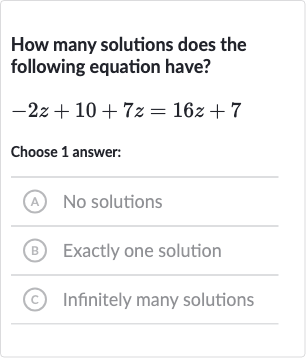Full solution
Q. How many solutions does the following equation have?Choose answer:(A) No solutions(B) Exactly one solution(C) Infinitely many solutions
- Combine like terms: Combine like terms on the left side of the equation.
- Rewrite the equation: Rewrite the equation with the combined terms.
- Isolate : Move all terms containing to one side and constant terms to the other side to isolate .
- Combine like terms: Combine like terms on both sides.
- Solve for z: Solve for z by dividing both sides by -11").\(\newline\$z = \frac{-3}{-11}\)
- Simplify the fraction: Simplify the fraction. \(z = \frac{3}{11}\)
More problems from Find the number of solutions to a linear equation
QuestionGet tutor help
QuestionGet tutor help
QuestionGet tutor help
QuestionGet tutor help
QuestionGet tutor help
QuestionGet tutor help
QuestionGet tutor help

